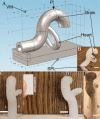Probing the Roles of Physical Forces in Early Chick Embryonic Morphogenesis
- PMID: 29939170
- PMCID: PMC6101520
- DOI: 10.3791/57150
Probing the Roles of Physical Forces in Early Chick Embryonic Morphogenesis
Abstract
Embryonic development is traditionally studied from the perspective of biomolecular genetics, but the fundamental importance of mechanics in morphogenesis is becoming increasingly recognized. In particular, the embryonic chick heart and brain tube, which undergo drastic morphological changes as they develop, are among the prime candidates to study the role of physical forces in morphogenesis. Progressive ventral bending and rightward torsion of the tubular embryonic chick brain happen at the earliest stage of organ-level left-right asymmetry in chick embryonic development. The vitelline membrane (VM) constrains the dorsal side of the embryo and has been implicated in providing the force necessary to induce torsion of the developing brain. Here we present a combination of new ex-ovo experiments and physical modeling to identify the mechanics of brain torsion. At Hamburger-Hamilton stage 11, embryos are harvested and cultured ex ovo (in media). The VM is subsequently removed using a pulled capillary tube. By controlling the level of the fluid and subjecting the embryo to a fluid-air interface, the fluid surface tension of the media can be used to replace the mechanical role of the VM. Microsurgery experiments were also performed to alter the position of the heart to find the resultant change in the chirality of brain torsion. Results from this protocol illustrate the fundamental roles of mechanics in driving morphogenesis.
References
-
- Taber LA. Biomechanics of Growth, Remodeling, and Morphogenesis. Appl. Mech. Rev. 1995;48:487–545.
Publication types
MeSH terms
LinkOut - more resources
Full Text Sources
Other Literature Sources




